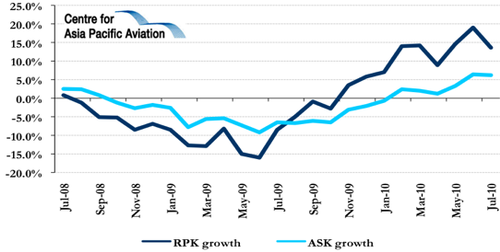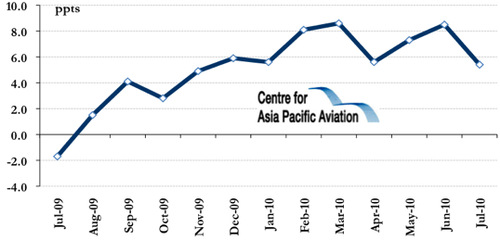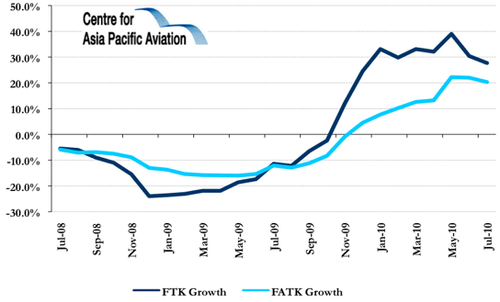Asia Pacific passenger and cargo traffic volumes return to pre-crisis levels
Asia Pacific full service airlines have been seeing a pick-up in passenger travel and air cargo demand in 2010, according to the Association of Asia Pacific Airlines (AAPA). AAPA commented that Jul-2010 traffic results "provide further evidence of the strength of the recovery in both passenger and freight markets, with volumes surpassing pre-recession levels", adding: "Commercial activity has also picked up strongly, leading to a rebound in premium passenger traffic on both regional and long haul routes"
AAPA traffic highlights for Jul-2010
|
|
Jul-2010 |
% Change |
|---|---|---|
|
Passengers (000s) |
17,205 |
+20.4% |
|
Traffic (RPKs) (mill) |
64,077 |
+!3.6% |
|
Capacity (ASKs) (mill) |
77,499 |
+6.2% |
|
Passenger load factor (%) |
82.7% |
+5.4 ppts |
|
Cargo traffic (FTKs) (mill) |
5,733 |
+27.7% |
|
Freight capacity (FATKs) |
8,011 |
+20.3% |
|
Freight load factor (%) |
71.6% |
+4.2 ppts |
AAPA passenger numbers growth and passenger load factor: Jul-2008 to Jul-2010
AAPA members carry record 17.2 million international pax in Jul-2010
In the latest month of data, AAPA members carried a record 17.2 million international passengers in Jul-2010, a 20.4% year-on-year increase (for the ninth consecutive month of growth and the sixth consecutive month of double-digit growth), boosted by particularly strong demand on busy regional routes, with the excellent results in both Jul-2010 and the seven months to Jul-2010 reflecting growing consumer confidence in the Asia Pacific region.
AAPA traffic highlights for seven months ended Jul-2010
|
|
Jan-2010 to Jul-2010 |
% Change |
|---|---|---|
|
Passengers (000s) |
106,372 |
+15.6% |
|
Traffic (RPKs) (mill) |
403,009 |
+12.3% |
|
Capacity (ASKs) (mill) |
511,057 |
+2.6% |
|
Passenger load factor (%) |
78.9% |
+6.9 ppts |
|
Cargo traffic (FTKs) (mill) |
36,995 |
+33.7% |
|
Freight capacity (FATKs) |
52,038 |
+16.4% |
|
Freight load factor (%) |
71.1% |
+9.2 ppts |
Overall international passenger traffic (RPKs) carried by Asia Pacific airlines increased 13.6%, surpassing highs achieved prior to the downturn. Coupled with a relatively modest 6.2% capacity (ASKs) expansion, the average passenger load factor increased by 5.4 ppts to 82.7%.
Carefully returning capacity to market
However, capacity growth in the month did represent the second largest increase in over 40 months (after 6.4% growth in Jun-2010) as the region's carriers made some "measured additions to capacity" and selective expansion across their networks. But AAPA noted that "continuing uncertainties about the prospects for further growth in North America and Europe suggest a measure of caution".
AAPA RPK growth and ASK growth: Jul-2008 to Jul-2010
Load factors reach new highs
This result marks the best load factor level in at least over 40 months and the 12th consecutive month of load factor gains.
AAPA PLF growth: Jul-2009 to Jul-2010
Double-digit freight growth
International air cargo demand (FTKs) for Asia Pacific airlines increased 27.7% year-on-year, underpinned by strong trade flows. Even with a 20.3% increase in freight capacity (FTKs), the average international cargo load factor gained 4.2 ppts to 71.6%.
AAPA FTK growth and FATK growth: Jul-2008 to Jul-2010
Outlook: Asia Pacific airlines now "generally well placed to benefit from improving business environment"; growth expected to taper but on track to restoring profitability
2010 has generally been a good year for Asia Pacific airlines, with reasonably low fuel prices, strong cargo demand and a recovery in business travel. Profits have flowed at most carriers. AAPA commented that Asia Pacific airlines are "generally well placed to benefit from the improving business environment".
However, Mr Herdman warned that the "very high growth rates recorded in recent months, as a result of the surprisingly sharp V-shaped recovery, will obviously taper off as the economy stabilises and reverts to a more normal pattern of growth".
Accordingly, the region's airlines are, according to AAPA, "still focused on careful management of capacity, tight cost controls, and ongoing efforts to achieve further productivity improvements as the industry strives to restore profitability after two years of heavy losses."
With the US economy apparently on a knife edge of returning to recession and European growth still weak, this caution is warranted.



